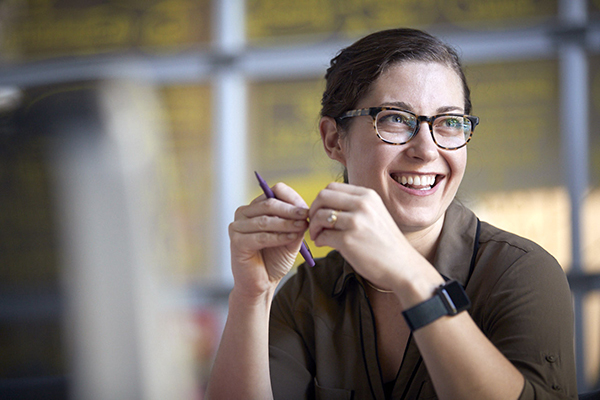Innovating through Remote Collaboration: The Benefits and Blockers.
For higher-level guidance on successfully innovating at a social distance, see the first blog in our virtual teamwork series, “What Does Innovating at a Social Distance Look Like? Three Practical Tips.”
With social distancing an everyday reality (as of this article’s publication), and off-site working, online meetings, and remote team collaboration becoming mainstream. It’s easy to focus on only the things we miss about face-to-face meetings, lunches around the conference table and especially, collaborative innovation sessions: Easy banter. Catered salads and bottomless coffee. The ability to get a solid read on participants without digging too deeply…
All that said, there are actually some benefits to remote collaboration too. We’ve found that having everything online and everyone in their own spaces can genuinely aid in the discovery, synthesization, and application of new ideas, insights, and roadmaps for the future. So, let’s look on the bright side for a moment and start there, with three good things about taking your innovation sessions online and away from the communal physical whiteboard. Then, we’ll address a bit of the bad too, because really, are you going anywhere soon?
Three Good Things About Remote Collaboration
1. Task-Specific, Invisible Staffing
We’ve taken the time to break down the roles that we find most valuable for remote collaboration through online sessions here. But let’s talk a bit about the one really valuable role that isn’t often present in live situations: a dedicated, entirely invisible tech expert.
Typically, something always goes awry during a workshop. The screen won’t recognize your laptop. The camera battery is dead. Your HDMI cable isn’t where you left it. And so, you call tech support, wait uncomfortably a bit, and then they fiddle with whatever it is until a solution is found. All the while, though, you’re losing momentum (and your participants’ attention), and everyone’s drifting into their phones. Online, however, your tech pro can do his or her job in the background without you missing a beat. The problems might be a bit different (a glitchy program, a participant locked out of the whiteboard app). Still, your dedicated tech person can be handling the issue out of view and not disrupting anyone’s flow in the process.
2. Cheaper, Faster Setup and Follow Through
No boxed lunches to buy. No pens and paper to source. No rooms to rent, logistics to manage, or plane tickets to buy. Once the remote collaboration tools are in place, there’s nothing physical left to purchase, and once everyone’s in the virtual “room” there’s little temptation to chat about the weather or last night’s Bachelor episode.
The ritual of settling into a quiet space, dialing in, and tuning into a screen-based collaboration creates a mindset of getting down to business that allows workshops to hit the ground running. It works great to settle participants, and the lack of setup lag time and fiddling with coffee and bagels for 10 allows us on the leadership side to jump right in and get the questions flowing.
3. You Can Take it With You
Two good things rolled into one here.
First, the lack of physical assets involved in a virtual workshop allows facilitators to shut the laptop end of the day and know it’s all there. Its already neatly collected into files, ready to be mined, and synthesized—no loose papers, unsticky sticky notes, or wandering “note and vote” dots to wrangle.
Secondly, you might hold a physical workshop in a room that’s only used for special events, or alternately, one that’s multi-purpose and is going to be broken down between days for another group’s use. Either way, facilitators and participants alike lose the object permanence of knowing where their best thought was. (On that sticky note just to the left of heading on the whiteboard, FWIW.). Visual anchors aid in recall and can, in one glance, take a person back to their train of thought hours later. With remote collaboration tools, it’s all still there, exactly where you left it, creating better memory flow between sessions and over time.
Now for the not great stuff…
Two Not So Good Things About Remote Collaboration (And What To Do About It)
1. Game Face: Mandatory
In-person as a facilitator, you may be subtly charming and delightfully humorous. But when nobody can physically feel the energy in the room, there is no room for subtlety. Anything less than “extra” comes off a bit like having the personality of wet cardboard.
Our tip: Turn up the volume on your gestures, your tone, and your energy. Having a presence that’s bigger than life and managing actively by connecting individually and often with participants is vital to keeping the momentum going.
2. Pre-Planning is Vital
During your virtual workshop, it takes a lot of time and energy to make sure everyone’s engaged, but beforehand, it takes much planning to make it feel seamless, and most of all, fun! It’s counterintuitive, but in-person, you can fake it a lot easier than when everyone’s eyes are trained on their little screen. You can’t hide, and the second you create a barrier you can’t overcome…you’ve lost them.
Our tip: Be 50% more organized on the front end than you would be for an in-person workshop. All the heavy lifting comes before you ever fire up the Zoom room – planning the engagement start to finish, prototyping it, and then testing it with your team. Bottom line: it’s incredibly important to know where you’re going and how to get there beforehand, or you’ll end up scrambling, biding time, or doing tech support rather than ideating.
Workshops of any type require a positive attitude. So, we’re happy we can identify more goods than bads in leading one virtually, whether by circumstance or choice. Everyone’s still getting used to this brave new remote world, so let’s make the most of it?
Need help planning, creating, or running a virtual research or collaboration project? Let’s talk. Contact THRIVE on discussing how we might help you facilitate collaboration with remote teams today.









